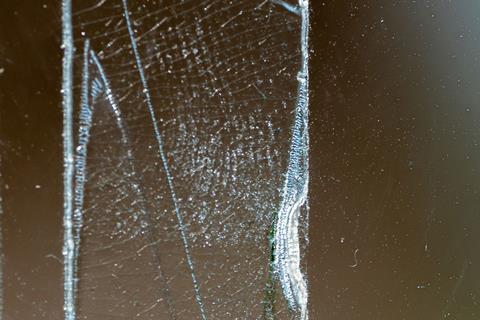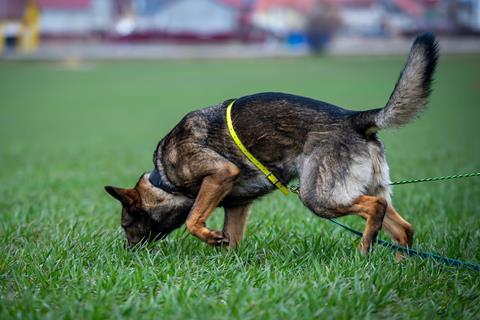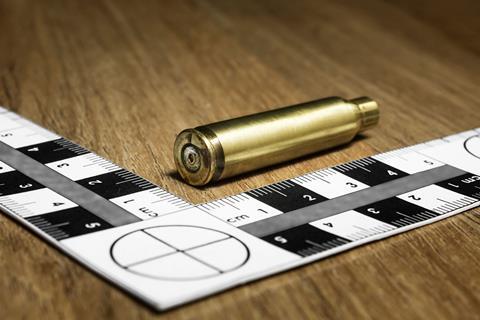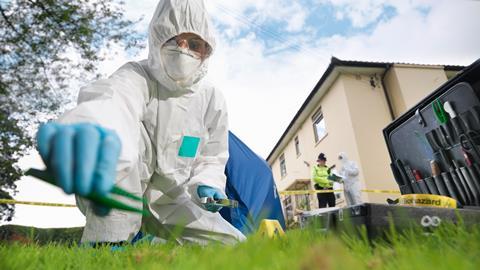Discover the groundbreaking chemical analysis they use to fight crime and even improve our health
Imagine a crime scene. Think about all the clues you might find there: traces of blood, hair or mysterious substances. Now, imagine all of them vanishing from the scene. It may be hard to believe, but this isn’t likely to worry a modern forensic scientist. We’ve become so good at fighting crime that we can even deal with what we can’t see, and it’s raising important questions about how chemists look at evidence.
This leap into the invisible isn’t down to new equipment: it’s about how much of a substance you need to find the answers you seek. ‘If you went back 20 to 30 years,’ says Amy Rattenbury, senior lecturer in forensic science at Wrexham University, ‘you’d need a blood spot about the size of a 50p piece to get a useable profile [for DNA testing]. Now, it’s probably less than the tip of a pinhead.’
Just because you find DNA somewhere, does it mean [the person] was ever there and, if so, how long ago?
Even though the amounts are smaller, forensic chemists still use the same analytical techniques that were pioneered decades ago, such as gas chromatography–mass spectrometry (GC–MS). It works by injecting a sample into the gas chromatograph part of the machine, where it is vapourised and carried through a capillary by an inert gas such as helium or nitrogen. The capillary is coated in a solid or liquid phase and the different components of the substance are separated out because they travel along the stationary phase at different rates. These are then ionised and detected in the mass spectrometer, where the different peaks created by the gas chromatograph provide a unique chemical picture.
In your class
Provide context and link chemistry to learners’ interests outside of the classroom, such as true crime podcasts, to help them make connections and recall knowledge. Sharing the article’s ideas and breathalyser reaction resource with your colleagues or using them in your own PSHE lessons may be a good hook to discuss the dangers of drinking and driving, as well as developments in analytical techniques.
DNA dilemma
DNA analysis, meanwhile, uses a method that will sound familiar to anyone who has taken an advanced Covid-19 test: polymerase chain reaction, or PCR. In the PCR test, a high temperature is used to break down DNA, then a mix of synthetic DNA primers (short single strand DNA fragments) and enzymes are introduced to start replicating the broken-down DNA fragments billions of times over. This allows scientists to get enough material to look at the recovered DNA and match it to a possible suspect.

Neither technique is new: PCR even won the Nobel prize in chemistry in 1993. But the amounts required are now so small, scientists have an entirely new problem: it can create a false picture of what really happened. ‘You’ve now got such small traces that there are big questions about where the actual DNA is even coming from,’ explains Rachel Bolton-King, associate professor of forensic science at Nottingham Trent University.
The problem is known as transfer persistence. For example, if you shook hands with someone, it’s entirely possible that their DNA would brush off on you. If you then committed a crime, their DNA could be found at the scene. And in some cases, no touching is even required. ‘There have even been reports about sampling DNA from the air and DNA transfer happening just through the air alone,’ says Rachel. ‘We know that dust has human skin cells in it and [there are] fragments of DNA just in our atmosphere … it’s starting to raise really big questions. Just because you find DNA somewhere, does it mean [the person] was ever there and, if so, how long ago? Or, how far can DNA travel in the air before it gets deposited?’

Download this
Demonstration and worksheet, for age range 16–18
Use the 'breathalyser' reaction to show an application of the oxidation of alcohols and develop your learners' observation skills.
Resources include:
Download this
Demonstration and worksheet, for age range 16–18
Use the ‘breathalyser’ reaction to show an application of the oxidation of alcohols and develop your learners’ observation and recall skills.
Download the resources from the Education in Chemistry website: rsc.li/3SGGY2b
‘How sensitive is too sensitive?’ Amy adds. ‘If we’re talking about microscopic traces, we have to decide if it’s relevant to our case. It’s not like [TV] crime shows where, if someone’s DNA is at a crime scene, they committed the crime. Our role now is how we interpret that evidence.’
If we can isolate the different compounds, we can teach those to the dog
Dog detectives

Modern researchers are also discovering new ways to solve crimes using chemistry. One of Amy’s interests is how search dogs can help track down bodies. ‘It’s very well established that if there’s a decomposing body buried underground, dogs will often be able to detect that,’ she explains. Yet, handlers are usually reluctant to use dogs around water – particularly salt water – as it would suppress the scent. According to the results of Amy’s research, this is probably a mistake. ‘We actually found that the dogs were more likely to find remains in salt water,’ Amy says. While this was only a simple study and there are huge challenges searching for bodies in deep water areas where there are tides, ‘if you’re searching in a small saltwater lake, there’s no reason that we’ve found so far to suggest that dogs couldn’t be effective.’
The explanation, Amy suggests, lies in basic chemistry. ‘If you look at fundamental science,’ she says, ‘osmosis would say that water moves from areas of high concentration to areas of low concentration. Salt water is [saltier] than cells, so that would encourage decomposition fluids to move out into the surrounding water. That means the fluids disperse, and the chance of the dog being able to smell this increases.’
Canine companions aren’t the only thing forensic scientists are training to help crack the toughest cases
Amy hopes smell is one of the areas that will start revealing major breakthroughs. As bodies break down, they release volatile organic compounds (VOCs) – carbon-based molecules that easily vaporise in the air. These compounds are a major part of how we smell and include everything from perfumes and fragrances to the smell of trees and farts. But the specific VOCs released as a body decomposes are very useful for forensic chemists. ‘If we can isolate the different compounds, we can teach those to the dog,’ Amy says. ‘And as we know the process of decomposition changes over time, with different chemical processes happening, they produce slightly different VOC profiles. We can use VOC profiles as a way of working out how long a body has been decomposing.’
Machine learning
Canine companions aren’t the only thing forensic scientists are training to help crack the toughest cases. One area Rachel is particularly excited about is artificial intelligence (AI), such as evidence from tape lifts: using clear sticky tape to pick up trace evidence such as hairs and fibres. Rather than just looking at them through a microscope as before, forensic scientists are developing SMMART microscopes – Spectral multimodal microscopes for the automated recognition of traces – to make the process even easier. These robotic microscopes use machine learning to automatically detect and analyse forensic evidence. ‘You would take the tape lifts and then use a SMMART microscope. You can actually do machine learning for automatic [mapping and analysis] of different trace materials. That’s probably the biggest change in forensic science over recent years, the potential for using AI across numerous forensic disciplines,’ she says.

Another example of how AI can help solve crimes is in studying fired ammunition, Rachel explains. ‘We’ve already demonstrated that there are features on the surface of fired cartridge cases that examiners don’t use, which can actually help us differentiate between different guns.’ When a person fires a cartridge, some of the cartridge case base is morphed into a volcanic crater. To a human eye, it looks random. ‘Using machine learning, we’ve been able to demonstrate that there’s really important information.’
A bloody tale
It’s not just firearms, either. Research is already underway into using AI for analysis of blood samples, to see if it’s possible to determine if the blood was left by a man or a woman. Once again, this raises serious ethical questions. ‘Obviously, there are loads of questions about how AI works and how it’s being used,’ Rachel admits. ‘It’s in its early days and people will have big questions around whether it’s appropriate to use AI. But there’s loads of potential there for using machine learning to help solve and investigate crimes.’
More resources
- Watch the Qualitative tests for organic functional groups practical video and use the supporting resources with your classes to identify a set of unlabelled organic compounds, including an alcohol.
- Use this microscale experiment with your learners to investigate the oxidation reactions between acidified dichromate(VI) and primary, secondary and tertiary alcohols.
- Showcase careers with a forensic scientist’s video job profile. Joni analyses biological samples for the presence of drugs and alcohols in relation to a person’s behaviour or a possible cause of death.
- Read Chemguide’s summary for more of the theory behind the oxidation of alcohols.
- Revisit prior knowledge learners have from their 14–16 studies with two levels of assessment questions on alcohols.
More resources
- Identify a set of unlabelled organic compounds, including an alcohol, with the Qualitative tests for organic functional groups practical video and supporting resources: rsc.li/3OHKCr7
- Investigate the oxidation reactions between acidified dichromate(VI) and primary, secondary and tertiary alcohols with this microscale experiment: rsc.li/3wgk7Tv
- Showcase careers with a forensic scientist’s video job profile (rsc.li/49u7bHK). Joni analyses biological samples for the presence of drugs and alcohols in relation to a person’s behaviour or a possible cause of death.
- Revisit prior knowledge learners have from their 14–16 studies with two levels of assessment questions on alcohols: rsc.li/3SWXsnX
This is only part of the work being done on blood. Scientists at the University of Albany, US, have used an analytical method, total reflection Fourier transform-infrared spectroscopy, to analyse existing blood samples and look at their unique spectral regions – a kind of chemical fingerprint based on the proteins, nucleic acids and carbohydrates present. The test means the team can tell the difference between human and animal blood; in time, it may be possible to build up a database and identify the blood of different animal species, too. All of this means that, rather than having to take samples back to the lab, they can very quickly identify whether blood belonged to a human or not – essential for speeding up justice in hit-and-run cases.
If the advances in crime busting aren’t exciting enough, there’s no reason these ideas can’t be applied elsewhere, says Rachel. Already, forensics is being used to save lives in medicine, where scientists use blood analysis techniques to diagnose diseases. ‘They’re now taking a smear of people’s fingertips as a non-invasive technique to detect for cancer,’ she explains. ‘And crime lights, which we’ve been using for years to detect body fluids, are also being used in healthcare, to try and minimise the potential for transferring diseases.’
It seems that chemistry is already so good at fighting crime, it’s now transferring those skills to improve our health too.
Kit Chapman is an award winning science writer. Resource update by Tim Jolliff and Sandrine Bouchelkia















No comments yet